Flumequine-Mediated Upregulation of p38 MAPK and JNK Results in Melanogenesis in B16F10 Cells and Zebrafish Larvae
Abstract
1. Introduction
2. Material and Methods
2.1. Regents and Antibodies
2.2. Cell Culture and Cell Viability Assay
2.3. Flow Cytometric Analysis
2.4. Cell Cycle Analysis
2.5. In Vitro Mushroom Tyrosinase Assay
2.6. Extracellular and Intracellular Melanin Content
2.7. Reverse Transcription-Polymerase Chain Reaction (RT-PCR)
2.8. Western Blotting Analysis
2.9. In Vivo Analysis of Melanogenesis in Zebrafish Larvae
2.10. Analysis of the Heart Rate
2.11. Statistical Analysis
3. Results
3.1. Flumequine Slightly Downregulates Mushroom Tyrosinase Activity In Vitro
3.2. High Concentrations of Flumequine Slightly Decrease the Viability of B16F10 Cells, but Does Not Induce Cell Death and Arrest the Cell Cycle at S Phase
3.3. Flumequine Increases Extracellular and Intracellular Melanin Production in B16F10 Cells
3.4. Flumequine Stimulates Expression of MITF and Tyrosinase in B16F10 Cells
3.5. Flumequine Upregulates Melanin Pigmentation of Zebrafish Larvae
3.6. Flumequine Induces p38 MAPK and JNK Phosphorylation, Resulting in Hypermelanogenesis
3.7. The p38 MAPK and JNK Signaling Pathway Upregulates Flumequine-Mediated Melanogenesis in B16F10 Cells and Zebrafish Larvae by Activating MITF and Tyrosinase
4. Discussion
5. Conclusions
Supplementary Materials
Author Contributions
Funding
Conflicts of Interest
References
- Bonaventure, J.; Domingues, M.J.; Larue, L. Cellular and molecular mechanisms controlling the migration of melanocytes and melanoma cells. Pigment Cell Melanoma Res. 2013, 26, 316–325. [Google Scholar] [CrossRef] [PubMed]
- Pillaiyar, T.; Manickam, M.; Jung, S.H. Downregulation of melanogenesis: Drug discovery and therapeutic options. Drug Discov. Today 2017, 22, 282–298. [Google Scholar] [CrossRef]
- Pillaiyar, T.; Manickam, M.; Namasivayam, V. Skin whitening agents: Medicinal chemistry perspective of tyrosinase inhibitors. J. Enzyme Inhib. Med. Chem. 2017, 32, 403–425. [Google Scholar] [CrossRef]
- Gunia-Krzyzak, A.; Popiol, J.; Marona, H. Melanogenesis inhibitors: Strategies for searching for and evaluation of active compounds. Curr. Med. Chem. 2016, 23, 3548–3574. [Google Scholar] [CrossRef] [PubMed]
- Niu, C.; Aisa, H.A. Upregulation of melanogenesis and tyrosinase activity: Potential agents for vitiligo. Molecules 2017, 22, 1303. [Google Scholar] [CrossRef] [PubMed]
- Hearing, V.J., Jr.; Ekel, T.M.; Montague, P.M.; Nicholson, J.M. Mammalin tyrosinase. Stoichiometry and measurement of reaction products. Biochim. Biophys. Acta 1980, 611, 251–268. [Google Scholar] [CrossRef]
- Slominski, A.; Tobin, D.J.; Shibahara, S.; Wortsman, J. Melanin pigmentation in mammalian skin and its hormonal regulation. Physiol. Rev. 2004, 84, 1155–1228. [Google Scholar] [CrossRef] [PubMed]
- Wu, Q.; Fung, A.H.Y.; Xu, M.L.; Poon, K.; Liu, E.Y.L.; Kong, X.P.; Yao, P.; Xiong, Q.P.; Dong, T.T.X.; Tsim, K.W.K. Microphthalmia-associated transcription factor up-regulates acetylcholinesterase expression during melanogenesis of murine melanoma cells. J. Biol. Chem. 2018, 293, 14417–14428. [Google Scholar] [CrossRef]
- Lai, X.; Wichers, H.J.; Soler-Lopez, M.; Dijkstra, B.W. Structure and function of human tyrosinase and tyrosinase-related proteins. Chemistry 2018, 24, 47–55. [Google Scholar] [CrossRef]
- Lajis, A.F.B.; Ariff, A.B. Discovery of new depigmenting compounds and their efficacy to treat hyperpigmentation: Evidence from in vitro study. J. Cosmet. Dermatol. 2019, 18, 703–727. [Google Scholar] [CrossRef]
- Liu, R.; Molkentin, J.D. Regulation of cardiac hypertrophy and remodeling through the dual-specificity MAPK phosphatases (DUSPs). J. Mol. Cell. Cardiol. 2016, 101, 44–49. [Google Scholar] [CrossRef] [PubMed]
- Camps, M.; Nichols, A.; Arkinstall, S. Dual specificity phosphatases: A gene family for control of MAP kinase function. FASEB J. 2000, 14, 6–16. [Google Scholar] [CrossRef] [PubMed]
- Kidger, A.M.; Keyse, S.M. The regulation of oncogenic Ras/ERK signalling by dual-specificity mitogen activated protein kinase phosphatases (MKPs). Semin. Cell Dev. Biol. 2016, 50, 125–132. [Google Scholar] [CrossRef] [PubMed]
- Luan, G.; Drlica, K. Fluoroquinolone-gyrase-DNA cleaved complexes. Methods Mol. Biol. 2018, 1703, 269–281. [Google Scholar] [PubMed]
- Hooper, D.C.; Jacoby, G.A. Topoisomerase inhibitors: Fluoroquinolone mechanisms of action and resistance. Cold Spring Harb. Perspect. Med. 2016, 6, a025320. [Google Scholar] [CrossRef] [PubMed]
- Schena, F.P.; Gesualdo, L.; Caracciolo, G. A multicentre study of flumequine in the treatment of urinary tract infections. J. Antimicrob. Chemother. 1988, 21, 101–106. [Google Scholar] [CrossRef]
- Grzelak, E.M.; Majer-Dziedzic, B.; Choma, I.M.; Pilorz, K.M. Development of a novel direct bioautography-thin-layer chromatography test: Optimization of growth conditions for gram-positive bacteria, Bacillus subtilis. J. AOAC Int. 2013, 96, 386–391. [Google Scholar] [CrossRef]
- Wang, W.; Zhang, W.; Liang, H.; Gao, D. Seasonal distribution characteristics and health risk assessment of typical antibiotics in the Harbin section of the Songhua River basin. Environ. Technol. 2019, 40, 2726–2737. [Google Scholar] [CrossRef]
- Jadhav, A.K.; Karuppayil, S.M. Molecular docking studies on thirteen fluoroquinolines with human topoisomerase II a and b. In Silico Pharmacol. 2016, 5, 4. [Google Scholar] [CrossRef]
- Hurault de Ligny, B.; Sirbat, D.; Kessler, M.; Trechot, P.; Chanliau, J. Ocular side effects of flumequine. 3 cases of macular involvement. Therapie 1984, 39, 595–600. [Google Scholar]
- Martinez, L.J.; Sik, R.H.; Chignell, C.F. Fluoroquinolone antimicrobials: Singlet oxygen, superoxide and phototoxicity. Photochem. Photobiol. 1998, 67, 399–403. [Google Scholar] [CrossRef] [PubMed]
- Adachi, T.; Satou, Y.; Satou, H.; Shibata, H.; Miwa, S.; Iwase, Y.; Yamamoto, T.; Nishida, A.; Masutomi, N. Assessment of 8-methosypsoralen, lomefloxacin, sparfloxacin, and Pirfenidone phototoxicity in Long-Evans rats. Int. J. Toxicol. 2015, 34, 16–23. [Google Scholar] [CrossRef] [PubMed]
- Beberok, A.; Wrzesniok, D.; Rzepka, Z.; Rok, J.; Delijewski, M.; Otreba, M.; Respondek, M.; Buszman, E. Effect of fluoroquinolones on melanogenesis in normal human melanocytes HEMn-DP: A comparative in vitro study. Cutan. Ocul. Toxicol. 2017, 36, 169–175. [Google Scholar] [CrossRef]
- Beberok, A.; Wrzesniok, D.; Otreba, M.; Milinski, M.; Rok, J.; Buszman, E. Effect of norfloxacin and moxifloxacin on melanin synthesis and antioxidant enzymes activity in normal human melanocytes. Mol. Cell. Biochem. 2015, 401, 107–114. [Google Scholar] [CrossRef] [PubMed]
- Brenner, M.; Hearing, V.J. The protective role of melanin against UV damage in human skin. Photochem. Photobiol. 2008, 84, 539–549. [Google Scholar] [CrossRef]
- del Marmol, V.; Beermann, F. Tyrosinase and related proteins in mammalian pigmentation. FEBS Lett. 1996, 381, 165–168. [Google Scholar] [CrossRef]
- Hwang, Y.S.; Kim, Y.J.; Kim, M.O.; Kang, M.; Oh, S.W.; Nho, Y.H.; Park, S.H.; Lee, J. Cannabidiol upregulates melanogenesis through CB1 dependent pathway by activating p38 MAPK and p42/44 MAPK. Chem. Biol. Interact. 2017, 273, 107–114. [Google Scholar] [CrossRef] [PubMed]
- Gu, W.J.; Ma, H.J.; Zhao, G.; Yuan, X.Y.; Zhang, P.; Liu, W.; Ma, L.J.; Lei, X.B. Additive effect of heat on the UVB-induced tyrosinase activation and melanogenesis via ERK/p38/MITF pathway in human epidermal melanocytes. Arch. Dermatol. Res. 2014, 306, 583–590. [Google Scholar] [CrossRef] [PubMed]
- Niwano, T.; Terazawa, S.; Nakajima, H.; Imokawa, G. The stem cell factor-stimulated melanogenesis in human melanocytes can be abrogated by interrupting the phosphorylation of MSK1: Evidence for involvement of the p38/MSK1/CREB/MITF axis. Arch. Dermatol. Res. 2018, 310, 187–196. [Google Scholar] [CrossRef]
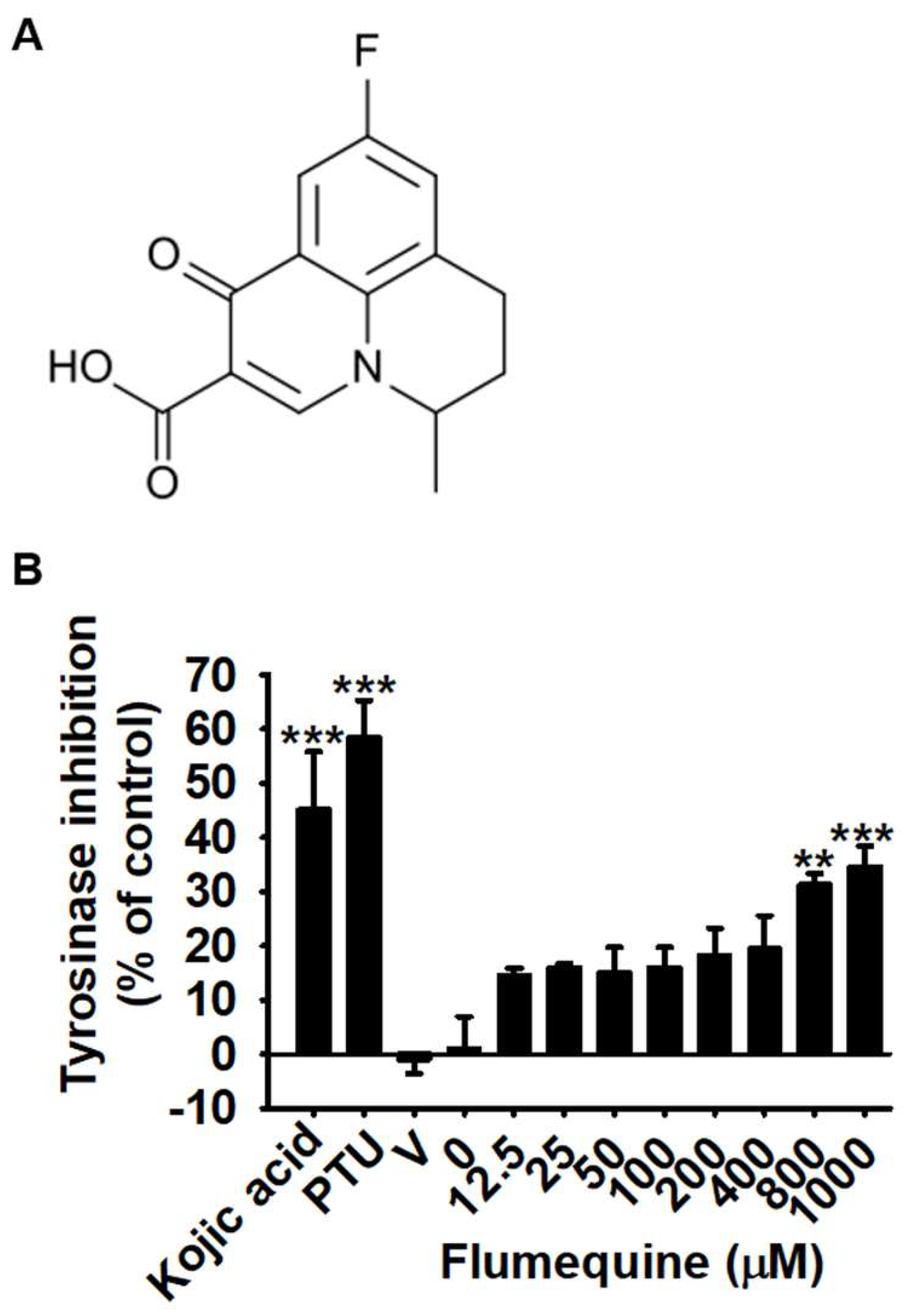
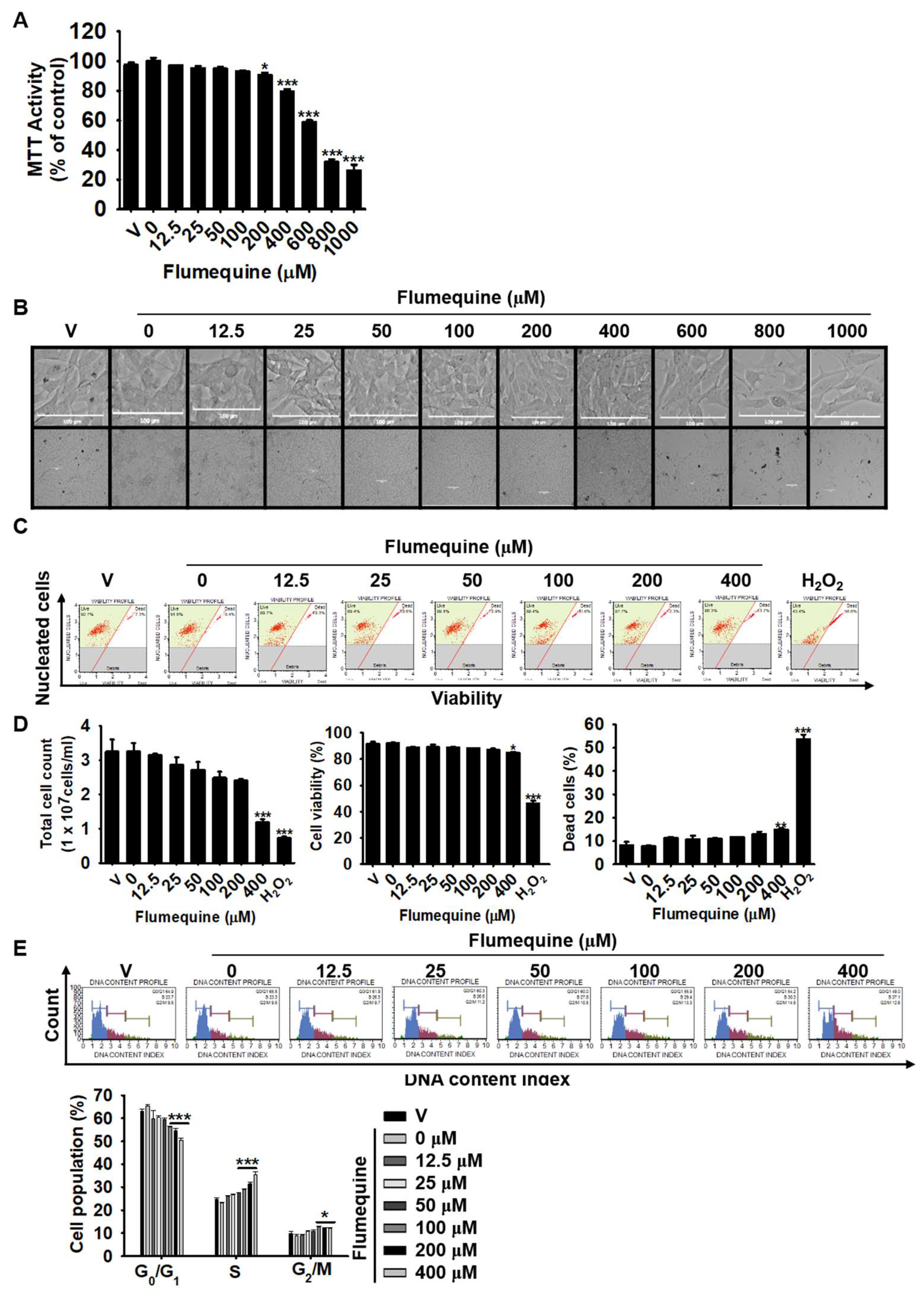
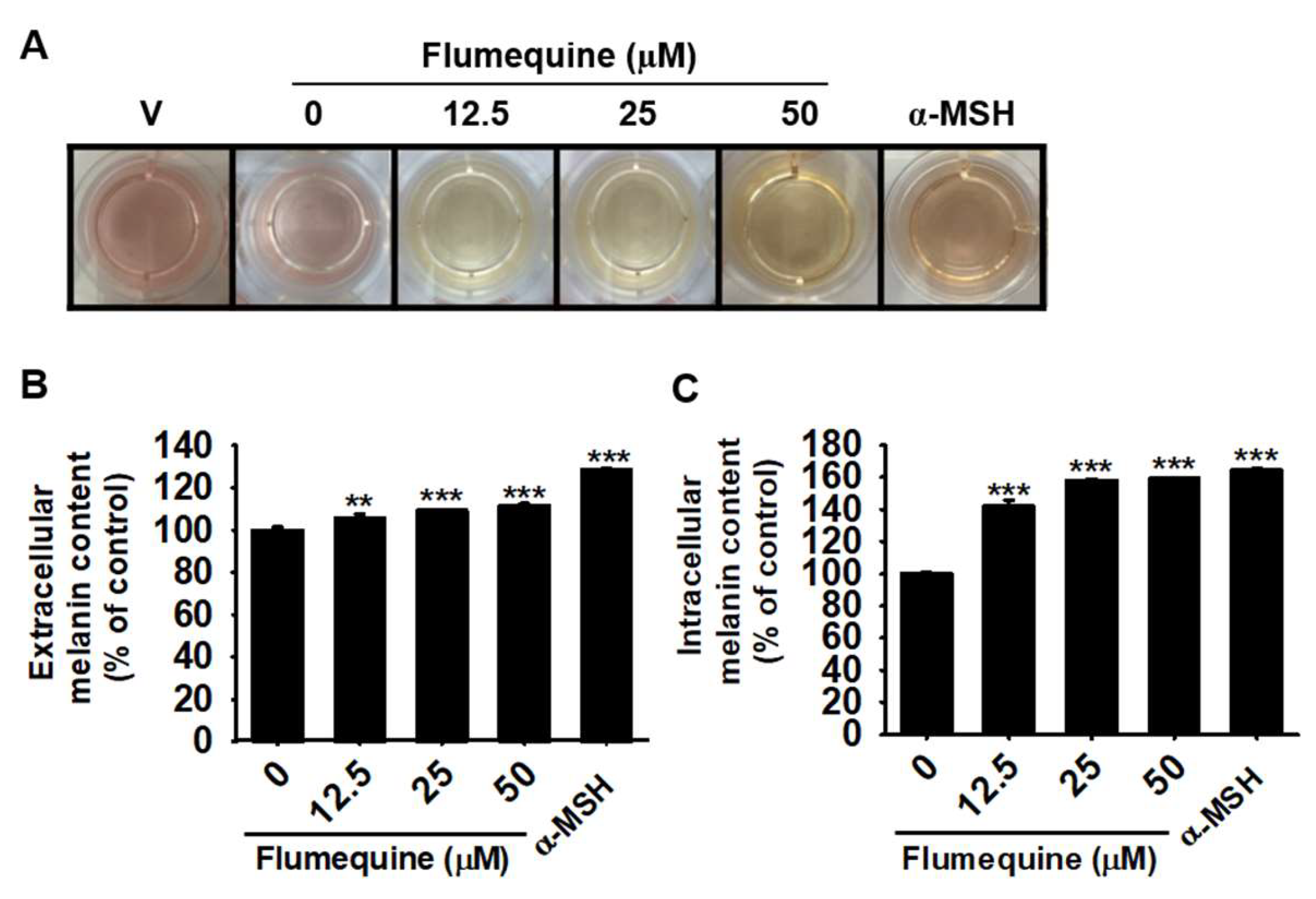
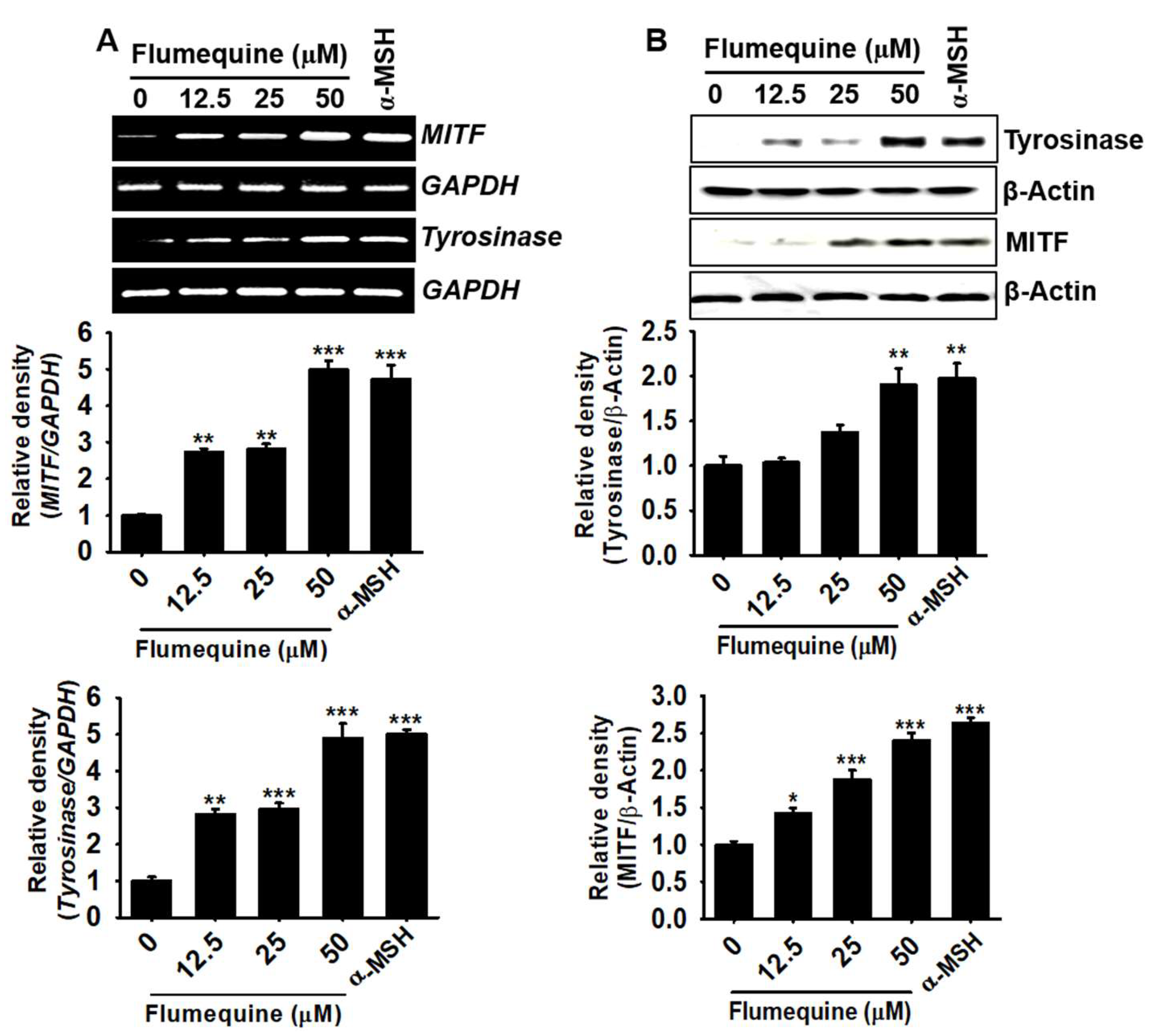
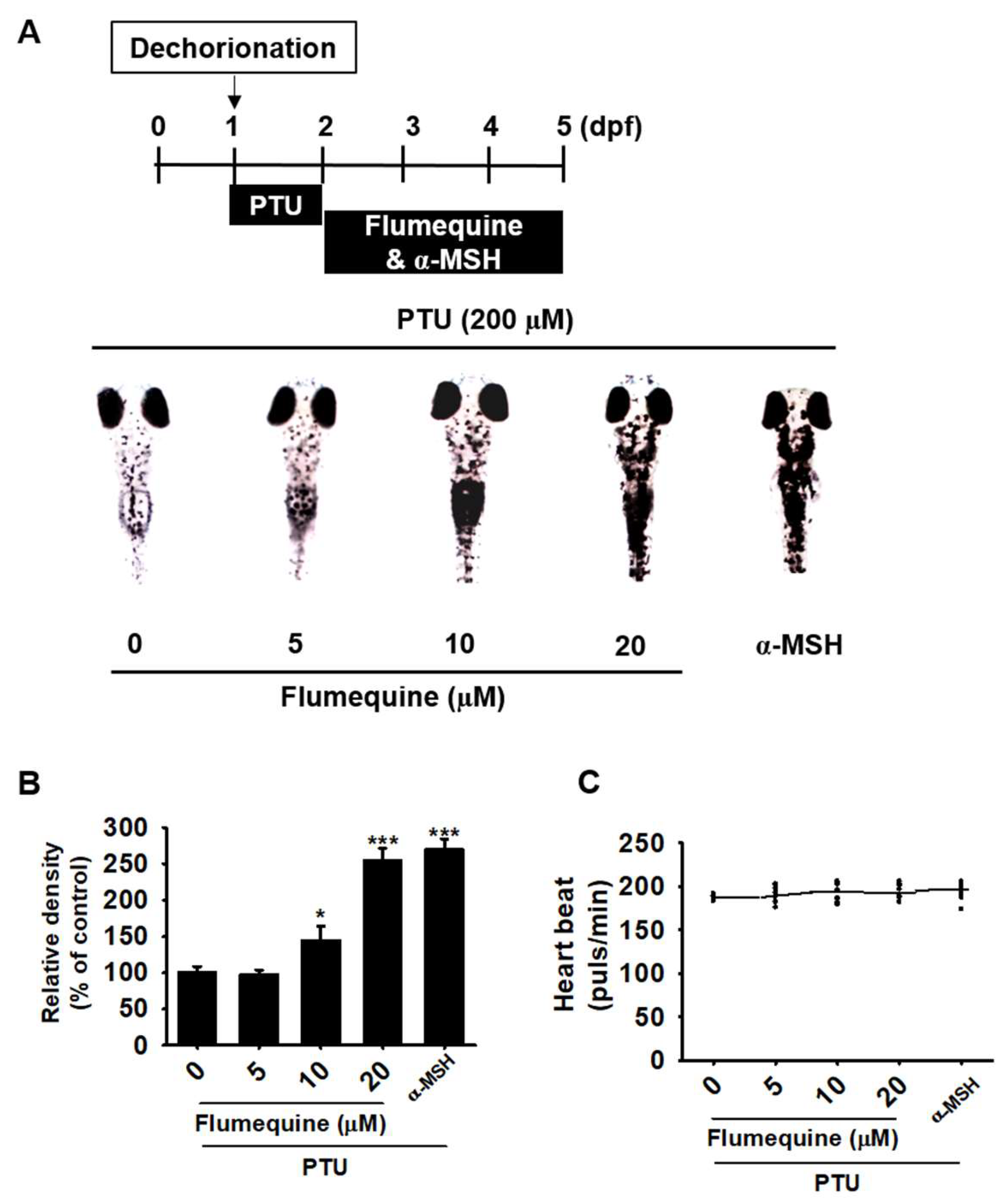
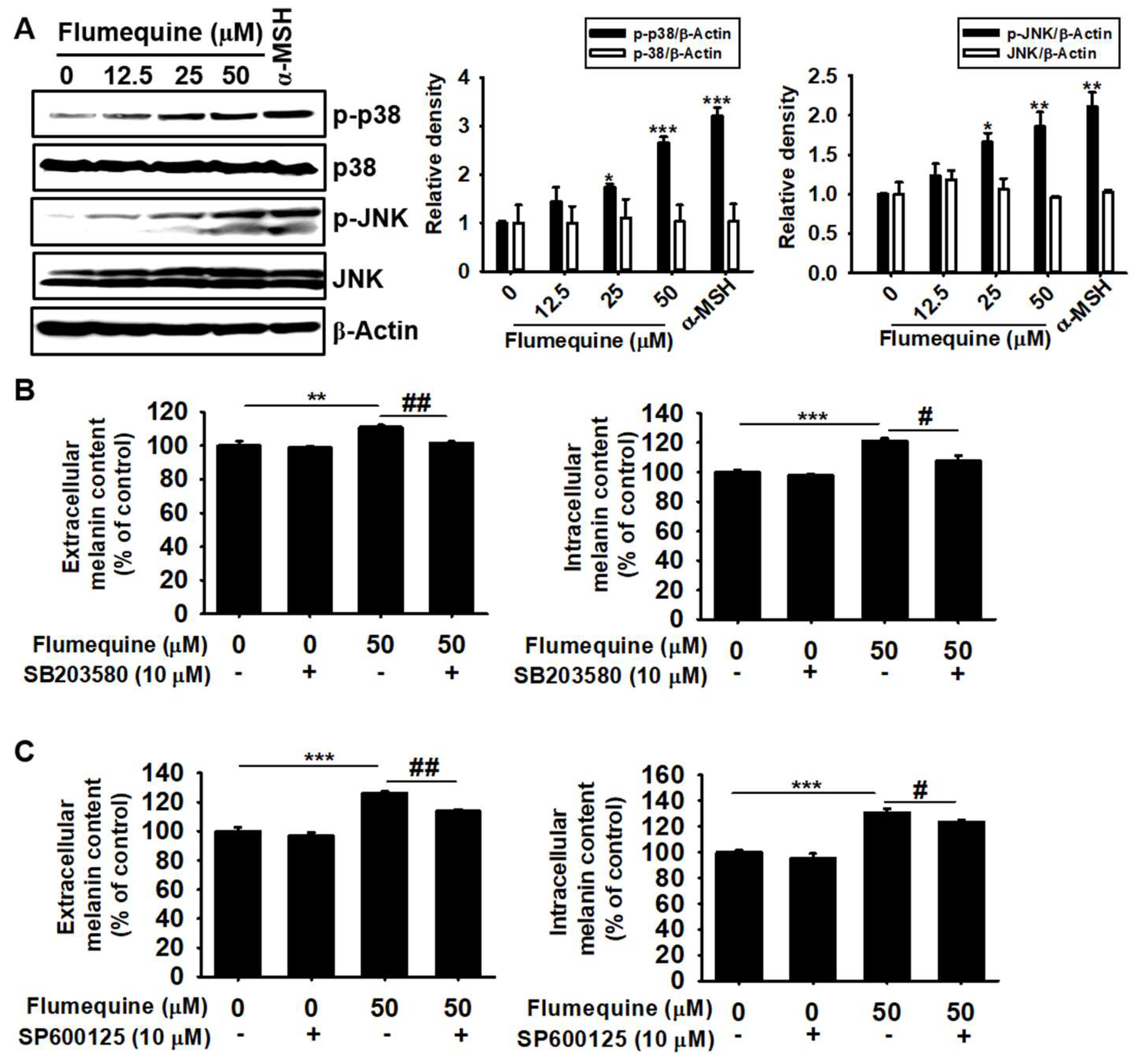

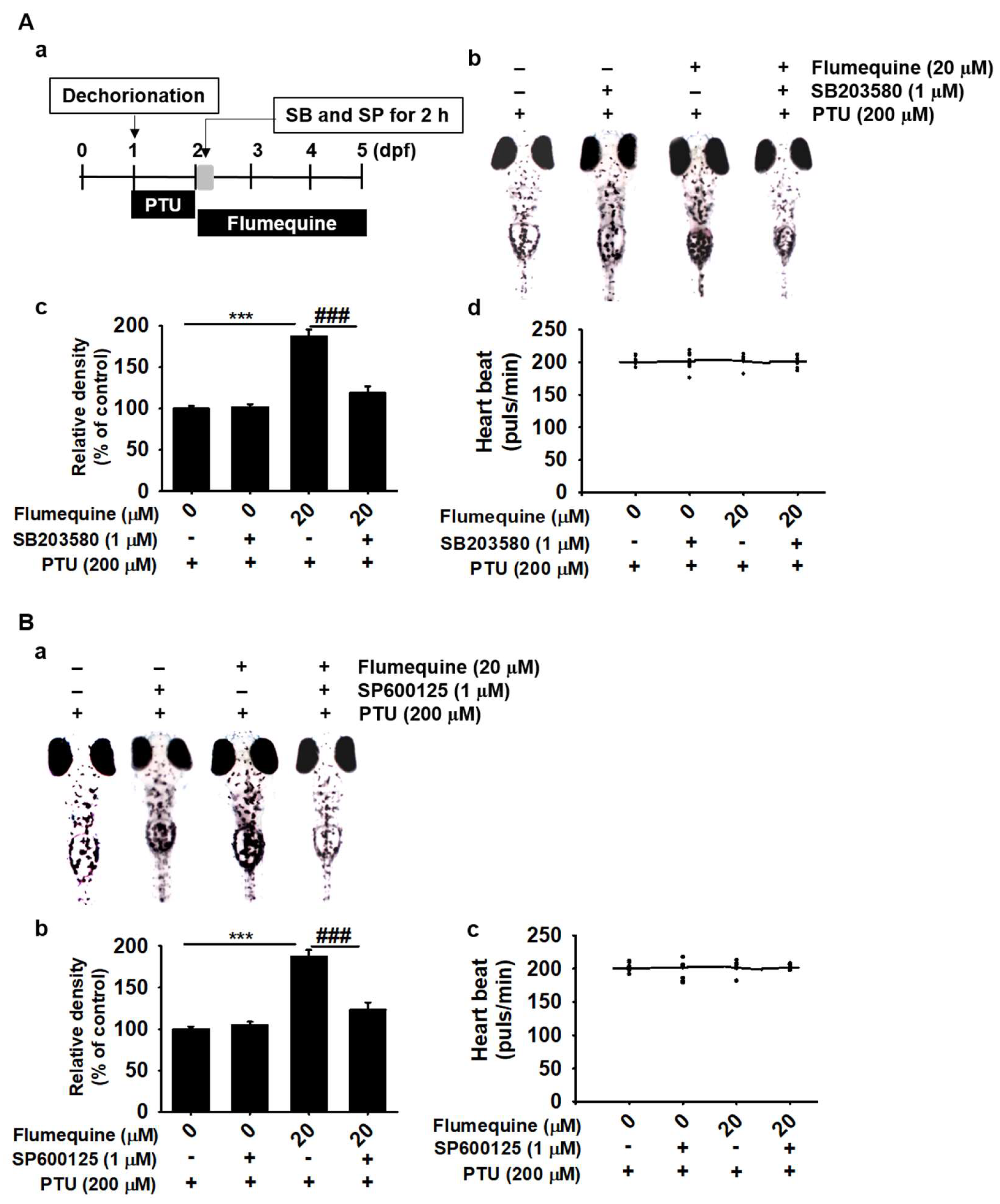
© 2019 by the authors. Licensee MDPI, Basel, Switzerland. This article is an open access article distributed under the terms and conditions of the Creative Commons Attribution (CC BY) license (http://creativecommons.org/licenses/by/4.0/).
Share and Cite
Karunarathne, W.A.H.M.; Molagoda, I.M.N.; Kim, M.S.; Choi, Y.H.; Oren, M.; Park, E.K.; Kim, G.-Y. Flumequine-Mediated Upregulation of p38 MAPK and JNK Results in Melanogenesis in B16F10 Cells and Zebrafish Larvae. Biomolecules 2019, 9, 596. https://doi.org/10.3390/biom9100596
Karunarathne WAHM, Molagoda IMN, Kim MS, Choi YH, Oren M, Park EK, Kim G-Y. Flumequine-Mediated Upregulation of p38 MAPK and JNK Results in Melanogenesis in B16F10 Cells and Zebrafish Larvae. Biomolecules. 2019; 9(10):596. https://doi.org/10.3390/biom9100596
Chicago/Turabian StyleKarunarathne, Wisurumuni Arachchilage Hasitha Maduranga, Ilandarage Menu Neelaka Molagoda, Myung Sook Kim, Yung Hyun Choi, Matan Oren, Eui Kyun Park, and Gi-Young Kim. 2019. "Flumequine-Mediated Upregulation of p38 MAPK and JNK Results in Melanogenesis in B16F10 Cells and Zebrafish Larvae" Biomolecules 9, no. 10: 596. https://doi.org/10.3390/biom9100596
APA StyleKarunarathne, W. A. H. M., Molagoda, I. M. N., Kim, M. S., Choi, Y. H., Oren, M., Park, E. K., & Kim, G.-Y. (2019). Flumequine-Mediated Upregulation of p38 MAPK and JNK Results in Melanogenesis in B16F10 Cells and Zebrafish Larvae. Biomolecules, 9(10), 596. https://doi.org/10.3390/biom9100596








